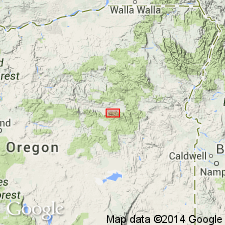
- Usage in publication:
-
- Canyon Mountain Complex*
- Modifications:
-
- Named
- Dominant lithology:
-
- Peridotite
- Gabbro
- Quartz diorite
- Granite
- AAPG geologic province:
-
- Blue Mountains province
Summary:
Named for Canyon Mountain which occupies area about 12 mi long by 5 mi wide across John Day quad, Grant Co, OR. Geologic sketch map shows several lithologic compositions: (1) quartz diorite and albite granite, (2) serpentine, (3) gabbro and norite, (4) pyroxene-rich peridotite and pyroxenite, and (5) olivine-rich peridotite. Intrudes volcanic and sedimentary rocks of which at least part are Late Permian in age. Is faulted off at east end and along north side. On west, Upper Triassic pillow lava, conglomerate, and graywacke lie unconformably on serpentine that forms border of complex. Complex believed to have been emplaced as crystal mush during Early to Middle Triassic time.
Source: GNU records (USGS DDS-6; Menlo GNULEX).
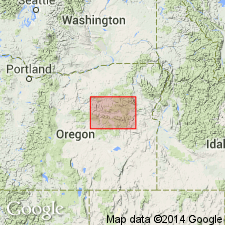
- Usage in publication:
-
- Canyon Mountain Complex*
- Modifications:
-
- Areal extent
- AAPG geologic province:
-
- Blue Mountains province
Summary:
Mapped in Canyon City 1:250,000 quadrangle, northeastern Oregon. Four lithologic compositions shown separately. Age given as Early and Middle Triassic. Map also shows intrusive rocks equivalent to Canyon Mountain Complex in northeastern part of quadrangle.
Source: GNU records (USGS DDS-6; Menlo GNULEX).
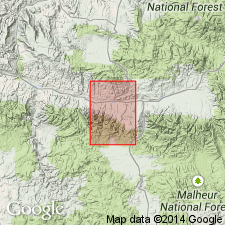
- Usage in publication:
-
- Canyon Mountain Complex*
- Modifications:
-
- Areal extent
- AAPG geologic province:
-
- Blue Mountains province
Summary:
Mapped in Mount Vernon 15' quad, Grant Co, OR. Quartz diorite described as small masses and irregular dikes mostly intruding Paleozoic rocks. Serpentinite described as derived mostly from peridotite; most contacts are sheared although not shown as faults. Metagabbro described as highly altered and sheared, emplaced with original peridotite. Age given as Early and Middle Triassic.
Source: GNU records (USGS DDS-6; Menlo GNULEX).
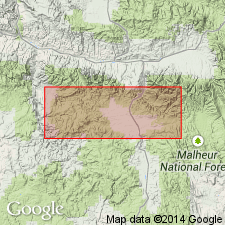
- Usage in publication:
-
- Canyon Mountain Complex*
- Modifications:
-
- Age modified
- AAPG geologic province:
-
- Blue Mountains province
Summary:
Peridotite and gabbro of Canyon Mountain Complex were not emplaced as magma in their present position (but like all alpine peridotite and gabbro which are allogenic) they were emplaced tectonically (Thayer and Jackson, 1972). These rocks now "regarded as older but perhaps not much older than the dated Permian sedimentary rocks of region (Boswick and Koch, 1962)." Quartz diorite and albite granite now appear to be Permian(?). Serpentinite and metagabbro are believed to be pre-Permian(?).
Source: GNU records (USGS DDS-6; Menlo GNULEX).

- Usage in publication:
-
- Canyon Mountain Complex*
- Modifications:
-
- Age modified
- Overview
- AAPG geologic province:
-
- Blue Mountains province
Summary:
Age is Early Permian based on fusulinids from limestone blocks in melange west of Dog Creek (Nestell, written commun., 1977). Structure, geologic setting, theories of origin included in this overview.
Source: GNU records (USGS DDS-6; Menlo GNULEX).
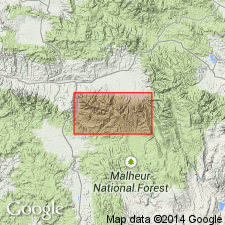
- Usage in publication:
-
- Canyon Mountain Complex*
- Modifications:
-
- Age modified
- Geochronologic dating
- AAPG geologic province:
-
- Blue Mountains province
Summary:
Shown on geologic map of Strawberry Mountain Wilderness Area and adjacent areas. Eight lithologic compositions shown separately. K-Ar ages of 250 to 225 Ma from plagiogranite and amphibolitic basaltic dikes of unit (M.A. Lanphere, written commun., 1973) suggest Late Permian age.
Source: GNU records (USGS DDS-6; Menlo GNULEX).

- Usage in publication:
-
- Canyon Mountain Complex*
- Modifications:
-
- Age modified
- Geochronologic dating
- AAPG geologic province:
-
- Blue Mountains province
Summary:
Age is Early Permian based on radiometric ages ranging from 276 to 268 Ma from unit.
Source: GNU records (USGS DDS-6; Menlo GNULEX).
For more information, please contact Nancy Stamm, Geologic Names Committee Secretary.
Asterisk (*) indicates published by U.S. Geological Survey authors.
"No current usage" (†) implies that a name has been abandoned or has fallen into disuse. Former usage and, if known, replacement name given in parentheses ( ).
Slash (/) indicates name conflicts with nomenclatural guidelines (CSN, 1933; ACSN, 1961, 1970; NACSN, 1983, 2005, 2021). May be explained within brackets ([ ]).

